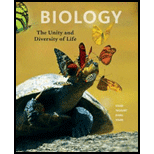
Concept explainers
New World monkeys _____.
- a. lack a tail
- b. are bipedal
- c. live only in Africa
- d. are dry-nosed primates
- e. are human ancestors
- f. all of the above
Concept introduction: The most advanced placental mammals are the primates. The primates are the only group of mammals that can extensively use their forelimbs for purposes other than locomotion. The primates have two suborders: Strepsirrhini and Haplorhini.
Answer to Problem 1SQ
Correct answer: New World monkeys are dry-nosed primates. Hence, the correct answer is option d.
Explanation of Solution
Reason for the correct answer:
During the early divergence of primates, they had two distinct lineages that include the wet-nosed primates (Strepsirrhini ) and the dry-nosed primates (Haplorhini). The dry-nosed primates include modern primates such as humans and monkeys. Refer Fig.26.2 “Proposed evolutionary tree for modern primates”, in the text. The lineage tree clearly shows that New World monkeys are Anthropoids that are diverged as dry-nosed primate from an early primitive ancestor.
Option d. is given as “are dry-nosed primates”. Since dry-nosed primates also include New World monkeys, the correct answer is option d.
Reason for the incorrect answers:
Option a. is given as “lack a tail”. New World monkeys do have a tail. Hence, option a. is incorrect.
Option b. is given as “are bipedal”. New World monkeys are not bipedal. Only humans are the primates that are bipedal. Hence, option b. is incorrect.
Option c. is given as “live only in Africa”. New World monkeys inhabit South America. Hence, option c. is incorrect.
Option e. is given as “are human ancestors”. The ancestors to humans are apes. Hence, option e. is incorrect.
Option f. is given as “all of the above”. New World monkeys are dry-nosed primates and none of the other options describes them. Therefore, the option cannot be 'all of the above'. Hence, option f. is incorrect.
Hence, options a., b., c., e., and f. are incorrect.
Want to see more full solutions like this?
Chapter 26 Solutions
Biology: The Unity and Diversity of Life (MindTap Course List)
- You intend to insert patched dominant negative DNA into the left half of the neural tube of a chick. 1) Which side of the neural tube would you put the positive electrode to ensure that the DNA ends up on the left side? 2) What would be the internal (within the embryo) control for this experiment? 3) How can you be sure that the electroporation method itself is not impacting the embryo? 4) What would you do to ensure that the electroporation is working? How can you tell?arrow_forwardDescribe a method to document the diffusion path and gradient of Sonic Hedgehog through the chicken embryo. If modifying the protein, what is one thing you have to consider in regards to maintaining the protein’s function?arrow_forwardThe following table is from Kumar et. al. Highly Selective Dopamine D3 Receptor (DR) Antagonists and Partial Agonists Based on Eticlopride and the D3R Crystal Structure: New Leads for Opioid Dependence Treatment. J. Med Chem 2016.arrow_forward
- The following figure is from Caterina et al. The capsaicin receptor: a heat activated ion channel in the pain pathway. Nature, 1997. Black boxes indicate capsaicin, white circles indicate resinferatoxin. You are a chef in a fancy new science-themed restaurant. You have a recipe that calls for 1 teaspoon of resinferatoxin, but you feel uncomfortable serving foods with "toxins" in them. How much capsaicin could you substitute instead?arrow_forwardWhat protein is necessary for packaging acetylcholine into synaptic vesicles?arrow_forward1. Match each vocabulary term to its best descriptor A. affinity B. efficacy C. inert D. mimic E. how drugs move through body F. how drugs bind Kd Bmax Agonist Antagonist Pharmacokinetics Pharmacodynamicsarrow_forward
- 50 mg dose of a drug is given orally to a patient. The bioavailability of the drug is 0.2. What is the volume of distribution of the drug if the plasma concentration is 1 mg/L? Be sure to provide units.arrow_forwardDetermine Kd and Bmax from the following Scatchard plot. Make sure to include units.arrow_forwardChoose a catecholamine neurotransmitter and describe/draw the components of the synapse important for its signaling including synthesis, packaging into vesicles, receptors, transporters/degradative enzymes. Describe 2 drugs that can act on this system.arrow_forward
- The following figure is from Caterina et al. The capsaicin receptor: a heat activated ion channel in the pain pathway. Nature, 1997. Black boxes indicate capsaicin, white circles indicate resinferatoxin. a) Which has a higher potency? b) Which is has a higher efficacy? c) What is the approximate Kd of capsaicin in uM? (you can round to the nearest power of 10)arrow_forwardWhat is the rate-limiting-step for serotonin synthesis?arrow_forwardWhat enzyme is necessary for synthesis of all of the monoamines?arrow_forward
 Biology (MindTap Course List)BiologyISBN:9781337392938Author:Eldra Solomon, Charles Martin, Diana W. Martin, Linda R. BergPublisher:Cengage Learning
Biology (MindTap Course List)BiologyISBN:9781337392938Author:Eldra Solomon, Charles Martin, Diana W. Martin, Linda R. BergPublisher:Cengage Learning Biology: The Unity and Diversity of Life (MindTap...BiologyISBN:9781305073951Author:Cecie Starr, Ralph Taggart, Christine Evers, Lisa StarrPublisher:Cengage Learning
Biology: The Unity and Diversity of Life (MindTap...BiologyISBN:9781305073951Author:Cecie Starr, Ralph Taggart, Christine Evers, Lisa StarrPublisher:Cengage Learning Biology: The Unity and Diversity of Life (MindTap...BiologyISBN:9781337408332Author:Cecie Starr, Ralph Taggart, Christine Evers, Lisa StarrPublisher:Cengage Learning
Biology: The Unity and Diversity of Life (MindTap...BiologyISBN:9781337408332Author:Cecie Starr, Ralph Taggart, Christine Evers, Lisa StarrPublisher:Cengage Learning
 Biology: The Dynamic Science (MindTap Course List)BiologyISBN:9781305389892Author:Peter J. Russell, Paul E. Hertz, Beverly McMillanPublisher:Cengage Learning
Biology: The Dynamic Science (MindTap Course List)BiologyISBN:9781305389892Author:Peter J. Russell, Paul E. Hertz, Beverly McMillanPublisher:Cengage Learning Concepts of BiologyBiologyISBN:9781938168116Author:Samantha Fowler, Rebecca Roush, James WisePublisher:OpenStax College
Concepts of BiologyBiologyISBN:9781938168116Author:Samantha Fowler, Rebecca Roush, James WisePublisher:OpenStax College





